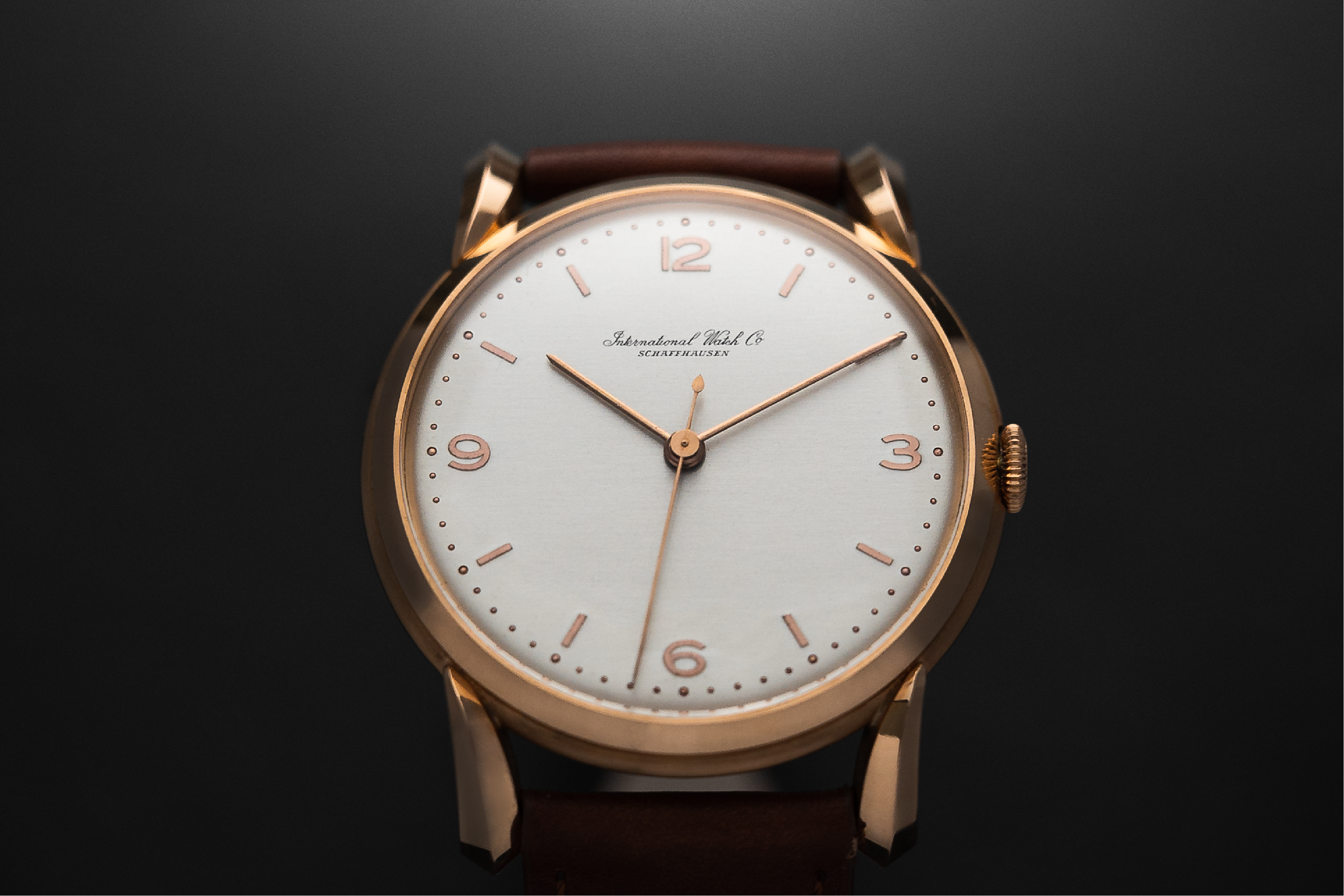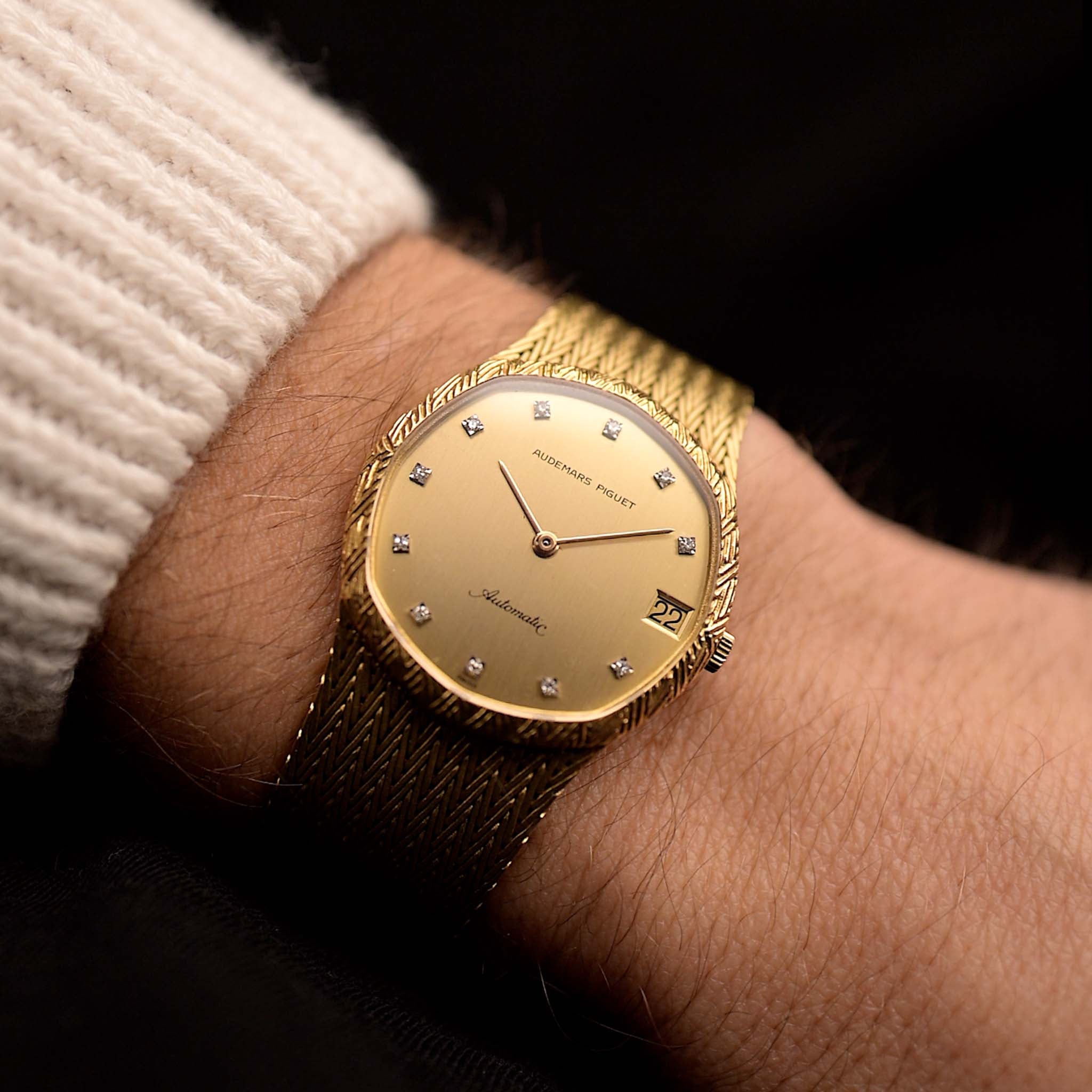What makes an IWC dress watch based on the Calibre 89 so special? It looks like a typical three-hand timepiece... In a nutshell, it is a fighter's heart in a royal body. A movement developed to endure the battlefield, reliably beating away inside a timeless mid-century design. IWC developed a one-of-a-kind three hand dress watch that clearly is more than meets the eye. A pivotal piece in many shapes and colors that is special without being rare.
March 22, 2021
Pivotal Dress Watches - IWC Cal. 89

Marcus Siems @siemswatches
Collector, Author, Data Analyst
What makes a dress watch not only very classy but also a milestone piece? Is it rarity... innovation... or market value? I believe that historical pieces do not necessarily have to be rare or expensive. Sometimes the strong workhorse deserve a place in history as well. And IWC dress watches based on the Calibre 89 are definitely one-of-a-kind masterpieces.
The Schaffhausen brand introduced the Cal.89 in 1946 and produced it for over 30 years until 1979[1-4]. The movement came as an innovative central-seconds three-hander, with hacking seconds (the second hand stops when the crown is pulled to optimally set the time). It is a simplistic manually wound caliber that was built like a tank.
 So much mid-century beauty... Take a closer look at this IWC-typical lug art - Shark Fin, Tear Drop & Twisted/Bombé (left to right). Photo @goldammer.me
So much mid-century beauty... Take a closer look at this IWC-typical lug art - Shark Fin, Tear Drop & Twisted/Bombé (left to right). Photo @goldammer.me
The Cal.89 originated from the Cal.83, the famous movement housed inside so many military watches of WWII (Mark X). This movement is nowadays famous as part of the "dirty dozen", the watches issued by the British Ministry of Defense[3-7].
Building upon the military heritage IWC built the Cal.89 to take the inevitable hit - the wheel-pins are heftier than typically and the screws and bridges thicker[1-2]. On top a sturdy spring construction was put in place to secure the central seconds hands against shocks. All adding to the rugged charm of a movement that would last. Not surprisingly the Cal.89 was integrated into the Mark XI, the famed pilot's watch of the British Ministry of Defense in 1948[1-3].
 If you ask me I definitely prefer them in all this non-military beauty. Photo @goldammer.me
If you ask me I definitely prefer them in all this non-military beauty. Photo @goldammer.me
So that's some great history but what has all of this to do with dress watches? Well, upon introduction the war was over and the demand for military issued watches decreased dramatically. IWC realized that they had a simplistic yet reliable movement at their hands that was perfectly suited for mass-production[4].
 Figure 1. Distribution of dial color, numeral layout, hand-style & hour markers (n = 106 watches)[8].
Figure 1. Distribution of dial color, numeral layout, hand-style & hour markers (n = 106 watches)[8].
Starting in the late 1940s until the 1960s IWC produced many of these "hybrid" dress watches - a fighter's heart beating in the body of a royal. Looking at the design probably the most distinguishable feature of these pieces have been the several fancy lug designs. They also had in common the size (35-37mm)*, they most often came in gold rather than steel and mainly featured a white dial.
 Somewhat of an outlier - an IWC Cal.89 dress watch in steel - only 24% of our analyzed pieces were made from stainless steel. But what a different vibe you get out of it! Photo @goldammer.me
Somewhat of an outlier - an IWC Cal.89 dress watch in steel - only 24% of our analyzed pieces were made from stainless steel. But what a different vibe you get out of it! Photo @goldammer.me
Nevertheless, the Cal. 89 watches showed quite some variations. Looking at the numerals, most of the dials featured none (48%), or at quarter positions (31%), then even numbered (14%) or with full numerals (7%).
Similarly, there has been quite the selection of different hand-styles - predominantly alpha (52%), pointer (28%), dauphine and leaf hands (both 7%) - and hour markers - favoring stick (65%) over dagger (11%), arrow (9%) and square markers (8%). So if there is such a broad selection of styles, the question arises whether we can extract some dominant dial configurations?
 Figure 2. Clustering the IWC Cal. 89 watches by design - dial, hand-style, marker-design, material, numerals, case-size, etc. - and extracting a total of 4 sub-categories (for the statistically inclined - tSNE + Gaussian mixed modeling).
Figure 2. Clustering the IWC Cal. 89 watches by design - dial, hand-style, marker-design, material, numerals, case-size, etc. - and extracting a total of 4 sub-categories (for the statistically inclined - tSNE + Gaussian mixed modeling).
The IWC Calibre 89 is not your typical "icon-material" as it comes in so many shapes and forms. Several sub-classes of the Cal.89 dress watches exist - identifying four main classes based upon their Zeitgeist. All showing their individual features and their own style.
We see for example that particularly later examples are often made in stainless steel rather than gold. Certain models are predominantly made from rose gold rather than yellow gold, emitting the warmth to heat your heart. I'm of course speaking about those sexy shark-fin lugged examples from the late 1950s to early 1960s (Did I make it too obvious what my favorite is?).
 I mean how can you not fall for this rose golden hue, the arrow hour markers and those incredible Shark Fins? Photo @goldammer.me
I mean how can you not fall for this rose golden hue, the arrow hour markers and those incredible Shark Fins? Photo @goldammer.me
All in all, the the mid-century dress watches that IWC designed around their magnificent manually-wound movement are everything but ordinary. They combine the reliability of a watch made for the trenches and top-of-the-class finishing with timeless elegance - potentially the ultimate everyday dress-watch.
That's why the IWC Cal. 89 is a pivotal piece. Not because of rarity, hype or a shameless drive to be different for difference sake. It is pivotal because it is a classic dress watch with an unnecessarily tough movement.
Looking good and being able to handle everything from the ball-room all the way to the battlefield. In many ways the IWC Cal.89 is the horological equivalent of Robert Downey Jr. as Sherlock Holmes - clever, posh, and one that can definitely take a punch or two.
*IWC Cal.89 Trivia - Did you know? There also is a rather rare IWC Calibre 89 dress watch with a squared golden case. And rumor has it there are the even rarer platinum Cal.89. During the 1960s IWC distributor to Japan - Isomura - made a small batch of platinum cases to fit the Cal.89 and Cal.853 (the automatic sibling). These platinum examples are sized at ~35mm and have supposedly been sold only on the Japanese domestic market[9-12].
References
[1] IWC Cal. 89 - a movement with military roots; Felix Goldammer, Goldammer;
https://www.youtube.com/watch?v=UbK6wEkkWiE
[2] Exceptional Movement in History: IWC Caliber 89; Ashton Tracy, Quill And Pad;
https://quillandpad.com/2018/05/23/exceptional-movements-in-history-iwc-caliber-89/
[3] Hall of Fame: IWC Caliber 89; Neil Wood, Wound For Life;
http://www.woundforlife.com/2014/12/03/hall-of-fame-iwc-caliber-89/
[4] Watches You Should Know: The IWC Cal. 89; Oren Hartov, GearPatrol;
https://www.gearpatrol.com/watches/a498432/watches-you-should-know-the-iwc-cal-89/
[5] In Depth: The story of "The Dirty Dozen"; A Collected Man;
[6] A look at IWC's Calibre 83; Horologium;
https://horologium.com.au/2012/11/21/a-look-at-iwcs-calibre-83/
[7] "Poor man's Patek" IWC cal 83 - 1941; Northernman, Omega Forums;
https://omegaforums.net/threads/poor-mans-patek
[8] Watches from Chrono24, extracted 2020 Nov. 29th & 2022 Feb. 8th; Karlsruhe, Germany;
[9] IWC Platinum Case Automatic (1961); Mr. Jones Watches;
https://mrjoneswatches.com/products/iwc-platinum-case-automatic-1961
[10] 1960s IWC Automatic Dress Watch With Caliber 853 in Platinum; Hodinkee Shop;
https://shop.hodinkee.com/products/iwc-cal-853-platinum-1?variant=33073286545483
[11] Vintage IWC Information; la_lusigne, Omega Forums;
https://omegaforums.net/threads/vintage-iwc-international-watch-company-information.41780/page-2
[12] Platinum IWC Cal 89; Old Watch Jason;
https://www.instagram.com/p/CVA2sSwBqrm/
All rights on text and graphics reserved to the Author.




























5 comments
Hello Vinh, thank you very much for your interest bu we do not take consignments. Have a great day, Marcus
Hi,
I HAVE a Shark Version 2, case 109 in MINT original condition in yellow Gold with Dagger (not lance) and even numbered hour markwrs. I would like to put it for sale on consignmwnt, how luch wpuld I receive? Thanks kindly
To the goldammer.me owner, Excellent work!
Hello goldammer.me administrator, Thanks for the well-researched and well-written post!
The cal 852 was also used in platinum watches made by Isomura in Japan and whilst a lot of the material on the subject suggests these were only made in 1960’s, they actually started at end of 1950’s. I know because I have one!
Also, it does also appear the cal 8531 (with date) was also used for some platinum watches.
Leave a comment